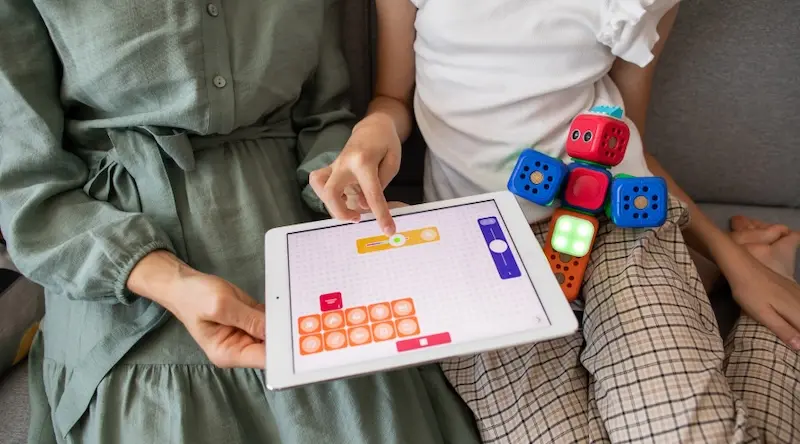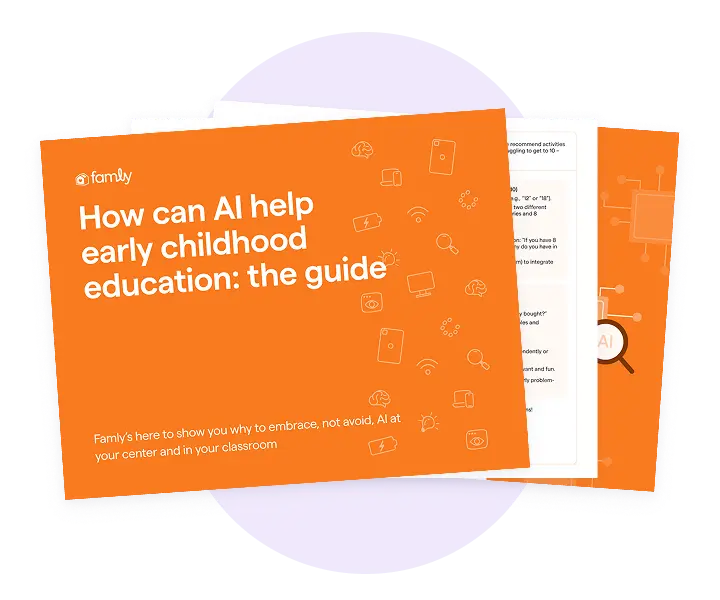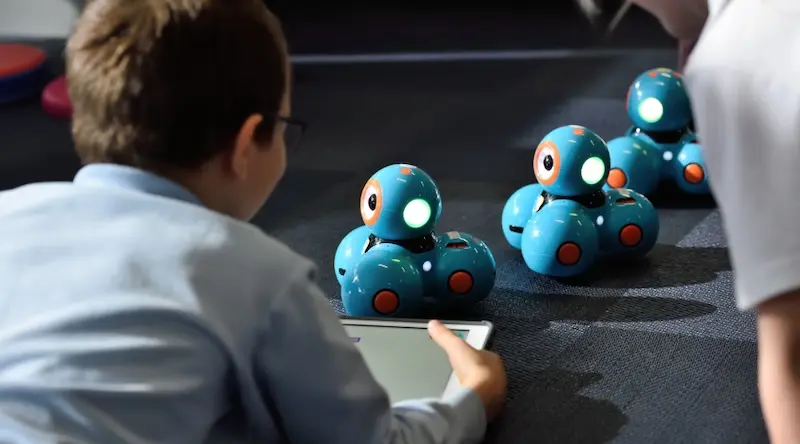settings
children
With Famly since
It feels like there are two conflicting opinions about Artificial Intelligence (AI). On one hand, people are fully embracing it, and on the other, people fear the possible data and privacy risks and that it may replace humans specifically in the workforce. Of course, there are also those in the middle who tend to avoid anything having to do with technology.
However, it is obvious that AI is not going anywhere, and actually, will likely just continue to advance and become a part of our daily lives more than it already is. It has recently been discussed more in the Early Childhood Education (ECE) sector.
This article aims to discuss the potential advantages and disadvantages of AI in ECE, and also hopefully, makes those who are more fearful of the idea feel more at ease by being more informed on the topic. I hope that if you have more knowledge about AI, then you will feel empowered to make informed decisions and choose how, or how not to, use AI in your classroom and childcare business.

What is AI?
Artificial Intelligence (AI) is a branch of computer science that aims to create systems and machines that are capable of performing tasks that typically require human intelligence and problem-solving abilities.
AI systems use algorithms (in the most basic explanation, an algorithm is a set of step-by-step instructions which explain how to perform a task) and compiled data. Then, the system analyzes and recognizes patterns in the stored, compiled data, which enables the machine to make informed predictions and decisions. Over time, AI can improve its performance. Ideally, AI will use the data to learn from the past in order to streamline and influence the machine or system’s future capabilities.
Simply, AI is like giving computers and machines the ability to think and learn on their own, similar to how people do. They are able to complete tasks, make decisions, and get better at them over time, so that they will not need constant instructions or inputs from humans.
While this is actually pretty impressive and groundbreaking, I also definitely understand how this may be a bit off putting and even scary.
Some AI you may be familiar with:
- Siri
- Alexa
- ChatGPT
- Self-driving cars
- Chatbots
- FaceID
The big ideas

AI in Early Childhood Education
AI has become an integral part of our daily lives, revolutionizing various industries and sectors. One area where AI has the potential to make a significant impact is ECE.
Some ways that AI can be used in the classroom is to automate and streamline mundane administrative tasks, from managing attendance and enrollment to enabling parents to set up auto-pay and more. Additionally, more recently, people have highlighted that it can also help children in their early development. PopBots and Duolingo are just two examples demonstrating how AI can be used to support young children and toddlers in a variety of topics ranging from speech and language development to STEM learning.
In this article, I will discuss:
Advantages of AI
- Ways that AI could support and benefit early childhood development in the classroom, such as personalize learning and one-on-one tutoring and supporting language development
- Ways that AI can assist teachers and ECE staff, such as streamlining administrative tasks and providing data about children’s development
Disadvantages of AI
- The possible disadvantages of AI, such as inability to understand data, the ambiguity of ethics and unintended biases, and privacy concerns.
- I will also emphasize that AI cannot and should not replace teachers ever.

AI for the children
Personalized learning
AI’s ability to personalize learning is one of the highest potential benefits for the children. With AI-driven systems, activities can be automatically adapted to each child’s learning journey, and taught at a pace that is suited specifically for them
But, it is easier to explain this with a hypothetical example.
Let’s imagine there is a stuffed animal that has AI technology. In other words, the stuffed animal is the AI machine. Let’s call the toy AIDAN (Get it?...because it starts with AI 😀)
There is a sweet spot when teaching younger children: how to make lessons and activities challenging enough that they develop new skills and acquire new knowledge, but also not too challenging that a child becomes uncomfortable, distressed and avoidant.
It can be tough for a teacher to find that unique sweet spot for each individual child, while simultaneously being responsible for the class as a whole.
Aidan, as an AI-powered toy, is able to provide activities that adapt to match the child’s pace of learning, preferred learning style, interests and challenges - and to overall provide scaffolding - for each individual child.
Ok, imagine this:
Tommy plays with Aidan for a little bit each day in the classroom. As Tommy plays, engages and interacts with Aidan over a period of time, Aidan gathers and stores data. This stored data means that Aidan develops a strong understanding of how Tommy learns, his pace of learning, his interests, and areas of struggle. Aidan can then utilize and analyze this stored data to prompt activities and lessons that are tailored specifically to Tommy.
For instance, through data accumulation, Aidan can recognize that Tommy is interested in nature, but struggling with math. With this data, Aidan can prompt activities like counting the number of red leaves to help keep Tommy engaged with activities he finds more challenging.
Additionally, children learn at different paces. If Aidan recognizes that Tommy is struggling with math, but excelling in language and speech development, Aidan can prompt math and language activities at different paces. Aidan can tailor lessons to the pace that Tommy is learning and progressing in each distinct area.
By tailoring the learning experience to each child's unique interests, learning styles and pace, AI not only boosts their individual development but also makes learning more enjoyable and engaging, setting a strong foundation for each child to thrive.
This possible level of personalized learning or one-on-one tutoring due to AI is actually pretty remarkable.
Language development
While all areas of development require personalized learning and one-on-one attention for optimal growth in early childhood, it is especially important for language and speech development.
The ability to speak aloud to another person who can provide instant feedback is essential when a child is learning a language, how to pronounce words, form sentences, expand their vocabulary and the basic fundamentals of conversation, like turn-taking.
AI can be extremely beneficial in helping young children develop their language and speech skills because it can offer accurate, instant feedback and assessment on pronunciation, vocabulary, comprehension, and fluency. Also, as mentioned above, AI can support language development at a pace that is a natural progression for each child.
Let’s take Duolingo as an example, since many of us (myself included) have used it to try and learn a second language. You know instantly if you made a mistake because you do not proceed to the next prompt unless you form the sentence, translate or pronounce the given text correctly. While Duolingo does not engage in a two-way conversation, that is definitely something that it could eventually do (like Siri or Alexa).
Let’s go back to Aidan and Tommy. Aidan could prompt Tommy to count the number of red leaves on the screen. However, instead of prompting Tommy to click the correct answer on a screen, Aidan could ask Tommy to respond verbally. Then, Aidan can correct Tommy if he mispronounces the word, or if he miscounted the number of leaves, or he could exclaim “Correct!” Rather than just moving on to the next lesson, Aidan may continue to ask questions about Fall and how leaves change colors, or ask what is Tommy’s favorite color, etc. Aidan can create conversations based on activities to enhance speech development. Also, this is one way that AI can foster interdisciplinary learning.
Aidan provides Tommy with instant feedback that a teacher can not provide when helping another child in the classroom. This consistent, individual attention and conversation with Aidan can help Tommy develop his skills and build his confidence in speaking, reading and comprehension. All at Tommy’s appropriate pace and development level.
Additionally, AI can also help with children’s confidence around communication and expressing themselves. Let’s use Alexa and Siri for this example. If an adult is not around to answer a question, a child can simply ask the AI machine: “Siri, why is the sky blue?” “Alexa, can you please play Sesame Street songs?”
These AI language bots will teach young children manners, like please and thank you. It will teach them to assert themselves and ask for what they want or need. It will teach them to be self-reliant. And, it is more interactive than scrolling on a screen or tablet to search for the answers.
Nevertheless, while I discuss the shortcomings of AI later in this article, I want to also highlight here that AI can still not replace the importance of physical signals in human interactions. Conversational speech relies on body language, facial expression, etc. which cannot be replicated by Siri or Alexa or other AI (yet!).

AI for Early Childhood staff
Streamline administrative tasks
AI systems can help streamline and increase efficiency of the more mundane administrative tasks including enrollment management, scheduling, attendance and digitizing tasks that may have previously been done with pen and paper.
Further, as AI machines perform these tasks and store data, it can begin to provide informative insights. For example, it can help with budget projections or provide an overall picture of attendance and enrollment patterns. These insights enable teachers and administrators to plan accordingly and to take action if they notice a concerning pattern, like a student missing many days, or frequently showing up late.
Using AI to perform these mundane tasks can reduce the burden on teachers and enable them to focus on providing high-quality, engaging and interactive lesson plans and activities. AI’s increased efficiency can contribute to a more engaging learning environment because the teachers can spend more time interacting with the children.
Teachers’ expertise is in helping children grow, not filing papers and tracking down payments. If AI assists with administrative tasks, teachers can apply their expertise how it should be: to foster children's growth and development as creative, emotional, social and thinking selves.
Data about development
AI can provide valuable data-driven insights about administrative tasks, overall business management, and also about each child's individual development and learning journey.
AI continuously collects, stores and analyzes data about the child's learning patterns and progress. The data-rich information that AI can provide to staff and educators enhances AI’s potential to foster personalized learning for each child.
AI provides a different type of development measurement that is more tangible and numerical. Having this type of data, in addition to what the teacher observes, will help ECE staff adapt and develop more individualized lesson plans and activities.
Improve staff's internal and external communication
We know how important family engagement is. It is essential for childcare businesses to have frequent parent-teacher communication. Whether a staff member is sharing a written observation, or sending a quick reminder about pick-up time, how you communicate is essential to build and maintain positive relationships. Of course, efficient and consistent communication between staff is also important.
AI can help improve all written internal and external communication. For example,
Famly’s newst feature, Sidekick Writing Assistant, will improve your staff’s internal and external communication. The Sidekick function support educators with their written work, by checking spelling and grammar or improving the tone of text.
The Cons of AI
Teachers must understand the data
As amazing as data-driven insights about each child's unique development is, it also brings up one of the potential risks of AI in the classroom: teachers must know how to understand and analyze the AI-generated data.
While AI can provide a wealth of data, it does not provide any meaning to the data. Therefore, it is the ECE staff’s responsibility to apply meaningful interpretation, and understanding how to translate AI’s data into actionable insights requires a level of data literacy that many educators may not have developed during their traditional training.
Therefore, it is critical that as AI enters the classroom, teachers are given the necessary time and training to improve their data analysis and interpretation skills, and empower them to use these insights to inform their teaching strategies and interventions.
Teachers should familiarize themselves with any AI machine or system they are considering incorporating into the lesson plan and classroom environment. For instance, they should interact with Aidan for a week or two. Is Aidan prompting activities and lessons in a way that is appropriate to how you learn, the pace that you learn at and the topics you are interested in. Does it challenge you enough? Not enough? Or too much?
Lastly, it is the teacher’s responsibility to speak up if they believe the AI machines and systems are not providing accurate data on development.
Yep - sometimes technology can be wrong!! It’s ok to be critical and skeptical of technology and AI. In fact, it is recommended so that you can be proactive and intervene when necessary.
Ethics
In AI, there are no ethical considerations. The systems are created to show you information and content that you have actively searched for, engaged with and have already shown any form of interest in.
This is most obviously seen in our social media newsfeed suggestions - mine is always giving me suggestions to buy new shoes, places to travel, and brunch spots. This can be dangerous if someone is showing interest in content that is discriminatory, violent or dangerous.
The same thing can happen with AI in the classroom. As mentioned above, Aidan can prompt activities that fit the individual child’s interests. However, what if the child is expressing interest about something concerning. We would not want Aidan to reinforce inappropriate interests and opinions.
Unintended biases
Additionally, AI may provide unintended biases. Just like any other digital system or software, it is created by people. Therefore, it is possible for AI machines in the classroom to have some internal bias programmed.
For instance, it may have a predisposed assumption of how a child should be developing at a certain age. Not all preschoolers grow up in the same family system, same financial status, same culture, etc.
If AI is providing data and interpretations about where a child is struggling and excelling, it is important to ask: How is that machine calculating that? What average is it comparing the child’s development to? It is important to be aware of the potential unintended biases that are programmed into AI.
Data and privacy
This does not require much more of an explanation. Of course, with data about children being saved, there is always a question of privacy: What and how much information is being stored about us, and who can access that information?
However, not collecting data means not having measurable data about how each child is progressing in their learning journey. Therefore, as AI enters the classroom, there needs to be restrictions and regulations around the data that is collected, and how it is shared and used.

Replacing teachers - saving the most important for last
I know I am repeating myself, but this is very important. AI cannot and should not replace teachers.
In the US, staff turnover, staff shortages and not enough funding for childcare providers is the reality. Therefore, it is understandable that many educators fear that AI will replace their jobs, as it appears to be more cost-efficient and streamlined.
However, there is no replacement for the physical, emotional, social, ethical and moral support that a teacher can provide, especially within the first 5 years of development. To name a few examples of what AI cannot provide: empathy and understanding emotions of others and facial expressions and physical reactions in interactions with others.
Instead, AI should be considered just another education tool that is available to teachers to improve their effectiveness, and support them in fostering their children’s growth and development.
Observations should not be written by AI
Also, even though AI may help streamline tasks like writing observations, this is not how it should be used. Strong observations need to include specific details that only the teacher and staff can write, such as the exact words that were said between two children, detailed explanations on how a child interacted with a specific toy, etc.
AI does not have the specific details to write observations that are truly beneficial to the growth and social, emotional, academic development as a child. AI may be able to assist with things like spell check, but should never completely write observations.
AI in the classroom: knowledge is power
I recently spoke with the Executive Director of Momentous Institute and Bilingual Clinical Psychologist, Dr. Jessica Gomez, who clearly explains why AI is not something that should be feared, but is definitely something that we need to learn more about before including it in ECE curricula and classroom activities.
AI will likely continue to advance, and become even more integrated into our daily lives. That can either scare you, or it can motivate you to become more knowledgeable about it. Understanding the pros and cons will help you choose which ways you will, or will not want to incorporate it into your classroom and childcare business.
Simply, this is one of those situations where knowledge is power. As Samia Kazi says, “The time to prepare our teachers to understand, monitor, analyze, and select appropriate AI applications to use in early childhood education is NOW.” There is definitely a learning curve for teachers to learn how to use and understand AI. You will need to allocate adequate time and resources to feel prepared and empowered. But, the learning needs to start today.
And finally, remember that ECE staff have the power to choose which AI systems to use for business management, and which to incorporate into their classroom and lesson plans. If the data it provides is not actually that insightful, or the children do not find the toy engaging, then maybe that AI system is not the best for your classroom or center, and that is okay.
I hope this article made you feel a little bit less apprehensive or fearful of AI entering the ECE classroom or childcare business. Instead, I hope you feel empowered to go learn more about it, so that you can make informed decisions about how you would want to utilize it.
And one more time, because it cannot be repeated enough: AI is simply a tool to support teachers in the classroom. It cannot, and should not, replace teachers.
How AI can help early childhood education
Did you find this article helpful, or even interesting? We dive more into how AI can help early childhood education in our free guide.
.webp)
Leave language barriers behind
Bring your multilingual community closer with an in-app live translation tool with over 130 languages.
Learn how live translation works







.jpg)

